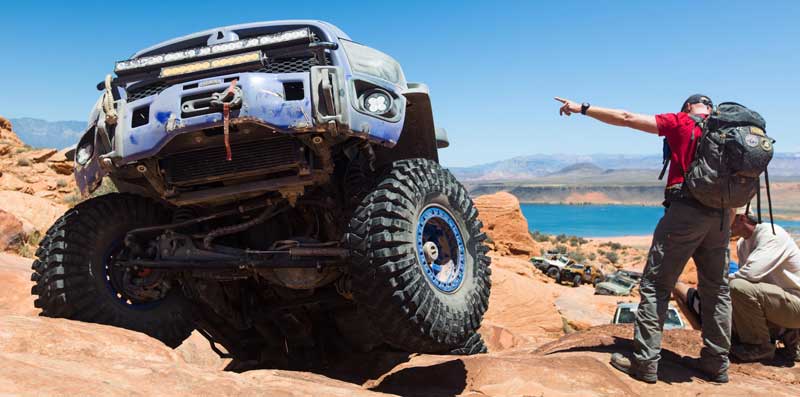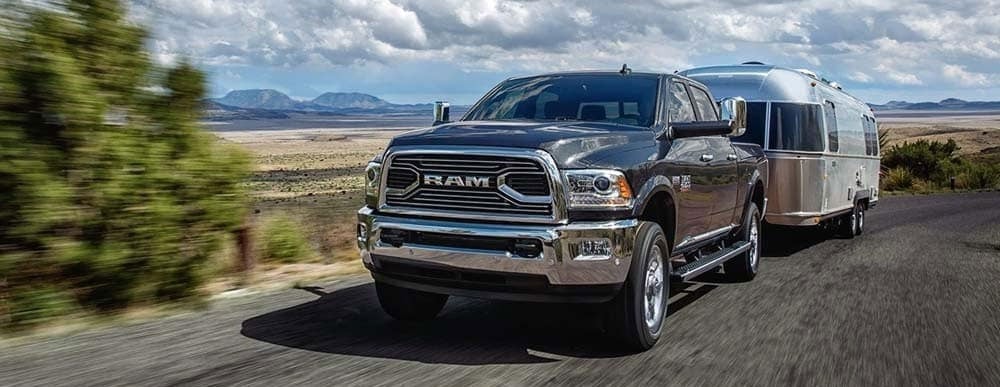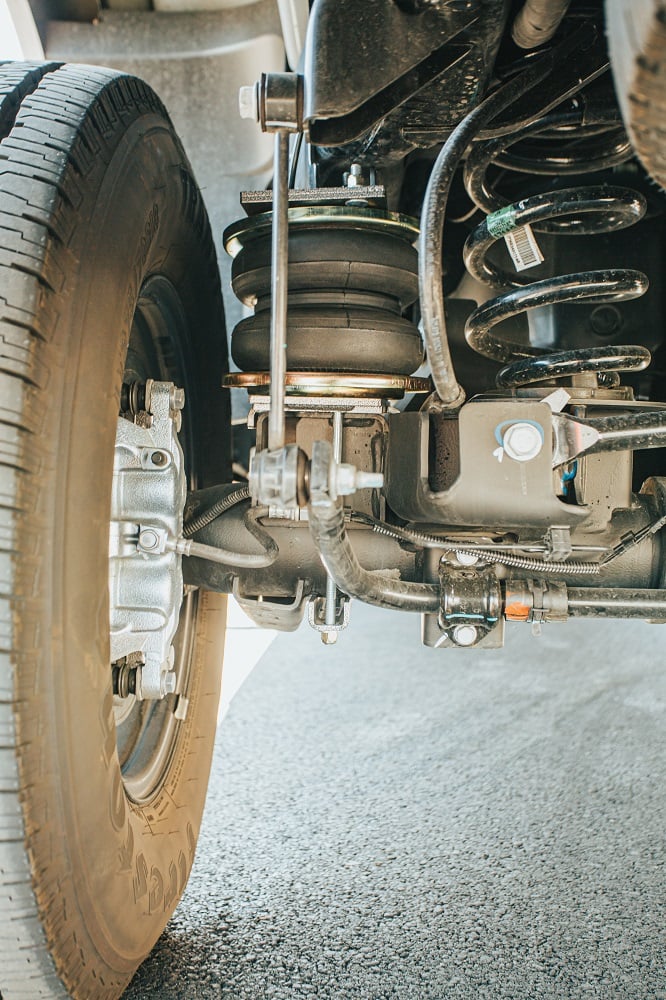Leaf springs have been part of vehicles suspension since the beginning, and on horse drawn buggies even before the motor car existed. Most passenger cars used leaf springs on all four corners until the 1940s, and on the rear until the late 1970s. Due to their industrial application, most 4wd pickups used leaf springs on all four corners until the early 1990s, but even today most pickup trucks still use leaf springs out back. They are simple to manufacture and install, durable, and depending on how many leaves are stacked together, a spring pack can hold tons of weight. In addition to suspending the truck, leaf springs are also responsible for locating the rear axle in position, and preventing the axle from twisting during acceleration. As the weight capacity of a leaf spring goes up, its spring rate (or stiffness) also goes up, so to hold a lot of weight most leaf sprung trucks tend to have a stiff ride. Although it is a somewhat outdated technology, the simple fact is leaf springs just work. So why would you want to try something different?
In 2014, Ram did just that and introduced a rear suspension design that had never before been used in a heavy-duty pickup truck. 4-link solid axle rear suspension has been used widely in a variety of rear-wheel-drive cars and SUVs like the Jeep JK Wrangler, but this was the first time it was ever used in a ¾ ton truck. The Ram 2500 still used the same AAM 11.5 rear axle found in earlier trucks, but instead of leaf springs holding it in place, four forward facing links and one lateral support link (panhard bar) locate the axle in place. The vast majority of 2014+ Ram 2500s use a steel coil spring to hold up the weight of the truck, but you could also elect to have the automatic leveling rear air-suspension option where an airbag replaces the steel coil.
There are many benefits to a multilink rear suspension since the duties of locating the axle and holding up the truck are split up. The links allow the axle to move up and down and articulate freely while preventing axle wrap during acceleration, and the links are angled in such a way that traction is enhanced. With the spring rate Ram chose, the coil sprung trucks have a much smoother ride quality than earlier leaf sprung 2500s, so overall it seemed like the swap to coil springs was a good move. But when you start talking about towing, some drawbacks to the system start to emerge.

A few owners have complained that when carrying a top-heavy load, the truck feels a little less stable than before, and this is attributed in part to the narrower spacing of the coil springs vs the leaf springs. While leaf springs are normally mounted on the outside of the frame almost to the tires, Ram installed the coils on the inside of the frame, giving the springs a narrower stance. When pulling light to moderate loads, the Ram 2500 is plenty capable and its towing ratings are in line with other ¾ ton trucks, but once you start looking at the data a little closer, things don’t add up.
Confusing Terms
When discussing towing and hauling, there are a lot of different ways that manufacturers rate the capability of their trucks, and there are a lot of numbers you need to know. Every configuration of truck will have a slightly different rating, as changing things like cab size, bed length, the axle ratio, or whether its 2 or 4wd can greatly change the weight rating of the truck. Usually, some of this information will be found on the sticker inside the door jamb, but if the sticker only lists the basics, you’ll have to open up the owner’s manual. The important ratings you need to know are as follows:
• Curb Weight: this is the weight of the truck by itself, totally empty. Usually, this figure is not published on the door sticker, but it is very important to know because it’s taken into account in almost every other weight rating listed.
• GVWR: gross vehicle weight rating. This figure is universally published on every vehicle on the road, including passenger cars. It’s not how much the vehicle weighs, but instead the maximum combined amount the vehicle and all its cargo are allowed to weigh.
• Max Payload: how much weight you are allowed to add to the vehicle, including tongue weight from a trailer. If you subtract curb weight from GVWR, you should get payload.
• Tongue weight: how much of the trailers weight is pushing down onto the truck. Typically, you want this to be 10-15% of the trailer’s total weight.
• GCWR: gross combined weight rating. This is the maximum allowed weight of truck, trailer, and any other cargo.
• TWR: Trailer Weight Rating. How heavy of a trailer you can tow.
• RGAWR: Rear Gross Axle Weight Rating. How much weight is allowed on the rear tires, including the truck, cargo, and trailer tongue weight.
2500 Class Truck Comparison
Since the most popular truck combination on the road today is a 4 door, short bed, 4wd, I’m using that configuration to make comparisons in ratings between each brand’s 2021 model year offerings. A coil sprung Ram 2500 with the 6.7 Cummins will have an average payload of about 2,095lbs and average TWR of 16,200 lbs. Those are averages across the six trim levels of Ram, and even with the same cab, engine, gear ratio, and bed configuration the figures vary widely. For example, a Tradesman 2500 has a payload capacity of 2,300lbs and a TWR of 18,290lbs but a Limited has only 1,880lbs of payload and a 14,030lb TWR. I’m not sure what makes up the 4,000lb drop in trailer rating from the low end to high end trim level, but we’ll at least compare using the average.
While 2,095lbs of payload and a 16,200lb TWR does sound like a lot when comparing to 1500 series trucks, when you compare it against other trucks in the 2500 category, things don’t seem to add up the same way. A new crew cab short box GM 2500HD has a payload of 3,563lbs (1,468lbs greater than the Ram 2500) but a similar 18,500lb TWR, and that rating doesn’t change if you get a WT, LT, LTZ, or High Country. The Ford F-250 which also uses leaf springs, has a payload of about 3,400lbs, and a max TWR of 20,000. While all 3/4 ton diesels are very capable when hauling a trailer, the one statistic you can’t help but notice is how much less payload the Ram 2500 is rated for.
So, what? The Ram can still pull a heavy trailer with its rear coil springs, so what difference does 1,500 pounds in payload make? Remember that payload is the amount of weight you can put in the truck, and that does include trailer tongue weight. Let’s say you are towing a 5th wheel toy hauler loaded up for a weekend camping trip, and the trailer weighs right at the limit for the truck at 16,000lbs. At this weight, you need about 1,600 pounds of pin weight in the bed of the truck for optimum trailer balance, but if you chose the Ram 2500 Limited, you’re nearly maxed out on payload, but you’re already 2,000lbs over the max TWR, so that’s a no-go. If you have a base model Ram 2500 Tradesman, luckily, you’ve got 700 pounds of reserve for the truck and 2,300lbs wiggle room on the trailer, but think of how quickly those 700 pounds will be taken up. A family of four and a Yeti cooler in the bed will easily make up that difference and put you right at the payload limit of the highest rated coil sprung Ram 2500 Diesel Crew Cab Short Box 4×4. By comparison, the leaf sprung GM and Ford 3/4 tons can haul the same exact trailer, but they’ll have 1,900 pounds payload left to play with. So, does this mean a coil sprung 3/4 ton truck is a bad idea? Well, not necessarily but it does mean you must understand the capability and limitations of the truck, and how it affects where you can put the weight. Don’t trade it in just yet, because there are a few upgrades you can install that will help it handle the weight and improve driver confidence.
2500 Towing Upgrades
First, it’s important to understand that any upgrades you install won’t actually raise your trucks GVWR rating, they will just make your truck better at handling that weight when you are at operating at your maximum GVWR. While there are always drivers who will ignore what the door tag says because “the truck can handle it” it’s important to know those numbers are provided by the manufacturer of the truck and the DOT doesn’t like to split hairs. Even if you’re not a commercial truck driver you can be stopped and weighed, and if you are found to be over the limit, you can face some pretty hefty fines.
That being said, the first problem you’ll want to combat is the truck squatting or sagging under load, and the simplest solution to this is a stiffer coil spring. Several brands are available that are rated to carry 35% more weight than stock which means the truck will sag a lot less, but the trouble with stiffer springs is you lose that plush ride the Ram 2500 is known for. Instead, a Helper Bag system will provide additional capacity when you are towing, but won’t affect your ride quality when you are unloaded. There are many different styles of helper bag, and Pacbrake’s Alpha HD air bag kit is designed to easily bolt into place and work with the existing coil springs, and when fully inflated, will add 7,500 pounds of load leveling capacity.
The basic airbag kit comes with the air springs, brackets, and air lines that allow you to inflate the bags in the same way you would pump up a tire with an external air source. If you tow infrequently this might be a good solution, but a much more convenient way to inflate and deflate would be to also install AMP’s in cab adjustability kit with a built in air compressor. Inside the cab you get a switch panel with a built-in pressure gauge, so with the touch of a button you can inflate or deflate the airbags and you can see exactly how much pressure you need to level out the load. Then once you unload, you can easily deflate the airbags to their minimum recommended level of 10 psi, so the truck rides smooth once again just like a stock 2500.
The next issue you can correct on the coil sprung Ram is the side-to-side sway caused by the narrower spring spacing. Every truck comes with an anti-sway bar installed up front, but for some reason manufacturers don’t always install them on the rear. Even if your truck has a stock rear sway bar, a stiffer aftermarket bar is a very helpful tool when you’re towing in general, but really comes into play with a top-heavy load like maybe a pair of snowmobiles on a flat deck above the bed. Hellwig rear sway bar kits are available for leaf and coil sprung trucks and the benefits are the same regardless of which design you have, but a coil sprung Ram will benefit a lot. By connecting each end of the axle to a common bar and the frame in the middle, the truck will remain much flatter as it turns, and some of the weight transfer force is resisted while providing zero drawbacks.
2500 or 3500?
While the coil sprung Ram 2500 provides an excellent ride quality when empty, it does have its limitations, so if you are in the market for a new rig and also need a lot more towing power, in some cases it makes sense to step up to the big leagues with a Ram 3500. The one-ton Ram has a lot of options that make is much more capable when towing, and best of all is the HO 6.7 Cummins with 1,075 lb.ft. of torque, and the much more durable AS69 transmission. Remember how the Ram 2500’s payload averaged 2,095lbs and the TWR was around 16,000? In the same exact crew cab short box SRW configuration, a Ram 3500 4×4 jumps up the average rating to 3,780lbs payload and 23,000lbs TWR, and yes, it runs leaf springs. Sure, its gonna ride rougher when empty, but that’s just the trade-off you have to accept when you need a heavy-duty tow machine. Slide in campers for example can weigh anywhere from 2,500lbs to 5,000lbs and they have a much higher center of mass than most loads, plus they’re affected by the wind a lot more since they are essentially a big sail, so a 3500 is almost a must in a situation like this. Also, larger 5th wheel campers and toy haulers can weigh well into the 20,000lb range when loaded up, which is well beyond what a 2500 can safely carry.
What to Do?
I think for the majority of truck owners, a Ram 2500 will be just the ticket. The increased handling of the 4 link and smooth ride provided by the coil springs will make it a dream to live with every day, and honestly most 2500 owners just use the trucks as commuters with the occasional hauling trip. If you plan on purchasing a Ram 2500 to tow with, just make sure you play with the options to make sure you get a GVWR that’s high enough for your usage, since the trim package you select can have such a huge impact on the weight rating. When it’s upgraded with better shocks, some helper bags out back, and a good sway bar it will handle max towing without any problems, and you’ll just have to pay attention to where you stack the weight and put more in the trailer than on the truck. As an owner of a GM 2500HD, I do appreciate the extra payload the leaf springs offer, but when its unloaded, I can tell you the ride quality is less than desirable. I think the no compromises solution nobody has widely used yet is a complete air-ride multi-link suspension just like semi-trucks use, but since the factory hasn’t offered this yet, maybe a Kelderman suspension equipped Ram 3500 is in your future…



Just purchased a Lance 650 camper which is designed for 1/2 ton pickups. When I load it onto my 2022 Ram 2500 4×4 6.7 Cummins I’m 200 lbs over on payload. I will be towing my 21 ft boat which weighs in at 5600 lbs. What would you do? If I trade the truck in, I’m taking a 20K loss.
I have a 2015 Ram 2500 Big Horn Diesel with a payload of 2360lbs and a 5th wheel with a pin weight of 2174lbs which is fine but when adding fuel, passengers and supplies i will be some 700lbs overweight. I know that nothing will rewrite the door sticker but i want to be as safe as is possible as I will be towing coast to coast in one month. What would you recommend, other than buying a 3500, to keep us safe, the drive stable and not kill us on bumps?
In advance, thank you for your comments and advice.
200 pounds over…run it